and MiG-27 in 1/72 scale
[ page 1 ]
1/72 scale kits of the MiG-23 and MiG-27 family (NATO "Flogger")
The famous Mikoyan-Gurevich design bureau of the Soviet Union designed in the nineteen-sixties a high speed MACH2 fighter design as successor of the MiG-21. The new single pilot design should have more firepower and range but also short take-off field distances. It initial design Model 23-01 ("MiG-23PD") had a delta wing which was no success and the later 23-11 design of 1967 got a variable geometry swing wing for better take-off and landing performance which was revolutionary at that time. The new wing got full span flaps and no ailerons, this function was done by the rear horizontal stabilizers referred to as tailerons.
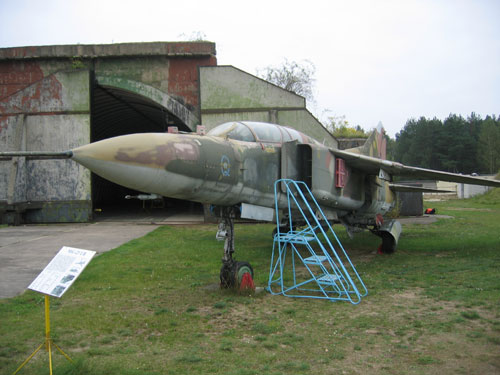 ....
....
Photo
of a MiG-23UB I took (I think it was at Finow?) in the former DDR
The later MiG-23 got the NATO reporting name "Flogger". The type came into production in the late sixties and seventies and thousands of aircraft were manufactured in various versions and exported to Warsaw Pact countries and other Soviet "friends". Also, a ground attack MiG-23 version was developed that later on evolved into the MiG-27 series.
Versions of the MiG-23 fighter are:
MiG-23S: the first operational MiG-23 with Lyulka R-27 engine had a clear a fighter role. First flown mid 1969, it got the NATO designation "Flogger A" but only produced in limited numbers and with a lot of teething problems; it often had a MiG-21 radar fitted with in its very pointy long radome but could fire 2 "Atoll" missiles. A twin barrelled 23mm GSh-23 gun was installed on the lower fuselage. Four pylons could be fitted, two below the wing glove and two below the fuselage. It had the first "type-1" wing had leading edge slats and straight leading edge. It also got four speed brakes at the aft fuselage that became standard for all MiG-23 production versions. The air intakes for the engine were relatively small with a simple splitter plate design.
MiG-23SM
("Flogger-A" also) of 1971 was an upgraded S that had the first good usable
Sapfir "high lark" radar and could fire the R-23 missile (NATO: AA-7 "Apex");
--------
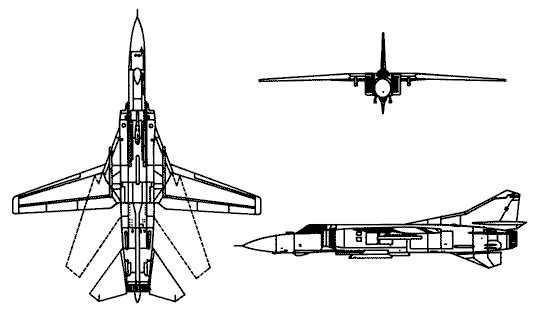 M
M
MiG-23M
("Flogger-B") fighter flew mid 1972 and the wing was the "type-2" wing;
it got an inboard leading edge sawtooth that resulted in a larger area
with extended leading edge. Wing sweep could be increased a few degrees
more but the separate leading edge slats were removed.
It got a far
better radar that was much more powerfull and a radar radome that extended
more to the rear and with larger radome width. The ejection seat was now
the KM-1. The rear fuselage brakes got external ribs for strength and a
new engine, the Khatchatourov design buro "Tumansky" R-29-300 engine with
a shorter jet afterburner nozzle. This required larger intakes
to
be fitted that later became the standard with also a slightly different
splitter plate design with boundary layer provisions.
The horizontal
stabilizers were moved more aft so the distance between wing and
stabilizers improved controls. Cable ducts were required below the stabilizers.
The vertical tail parachute fairing got a bit shorter shape.
Many aircraft
were produced but fatigue problems were large; during production the metals
used were changed. Also during service life, the pilot canopy got a "mid
frame" and trim tabs were fitted inboard to trailing edges of the horizontal
stabilizers/tailerons and the tail rudder got an extra hinge. The ventral
lower fin fixed fairing got a leading edge extension.
Systems allowed the short range R-60 (NATO: AA-8 "Aphid") missile to be fired, replacing the earlier K-13 (NATO: AA-2 "Atolls") missiles. Also the R-23 (AA-7 "Apex") long range missiles could be fired, positioned on a new pylon "with a gap" below the wing glove. On two outboard wing pylons, rather large fuel tanks could be fitted but these would need to be jetttisioned before swinging the wing aft. As a secondary role, also bombs like the FAB-100 could be fitted and dropped as well as unguided rocket pods. Often, a Doppler system was fitted with a small port fairing at the lower forward fuselage far below the cockpit and antennas were repositioned.
MiG-23MF ("Flogger-B" NATO code retained) was the export version similar to the MiG-23M and widely used by the Warsaw Pact like Bulgaria, CzechoSlovakia, East Germany DDR, Hungary, Poland, Romania and countries like probably Angola, Cuba, India, Syria.
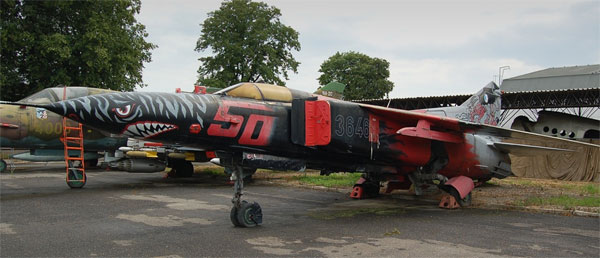
Photo
of a MiG-23MF I took at the museum in Kbely (Czech republic) in 2005
MiG-23MS
("Flogger-E") was the export version of the M. It had the simpler Jay Bird
RP-22 radar (with a bit shorter fiberglass radar radome but same nose length)
and it could not fire the AA-7. MiG-23MP (Flogger-E") was
an MS with a dielectric head above the pylon. Used probably by Cuba, Libya,
Syria.
------------
MiG-23U
("Flogger-C")
was the two seat trainer version probably based on the "S" but with lengthened
forward fuselage and the R-27 engine. It had no Sapfir radar. The cockpit
for the instructor was aft of the pilot cockpit that required removal of
a fuel tank and the dorsal streamline spine was also adapted. The rear
cockpit canopy had a retractable periscope fitted for the instructor to
see forward of the aircraft.
MiG-23UB ("Flogger-C") was similar to the MiG23U but with R-29 engine. It had no Sapfir radar but got a illumination pod below the starboard wing root to allow for the AA-7 "Apex". The MiG-23UB also had double slotted trailing edge flaps. Later aircraft got the "type-3" wing that also enabled 3 external fuel tanks (as the "U" design required the internal fuel tank to be removed for the rear cockpit). Of the UB was many hundreds were produced and the aircraft was used by many countries for jet training.
MiG-23UM
("Flogger-C") trainer was based on the MiG-23M but was a two seat trainer
using also the changes of the earlier U. Early aircraft had the R-27-300
engine but this was soon the R-29B that looked very similar and early aircraft
had a single hinge rudder and no trimtabs on the tailerons. The small Jay-bird
intercept radar was installed in a similar nose as the "Flogger-E". The
lower ventral has a straight leading edge. For training, it had required
systems and pylons to fire the "Atolls" and "Aphid" missiles as well as
bombs or rocket pods. A GSh-23L cannon could also be fitted. This UM was
exported in large numbers as trainer also for other type of Soviet aircraft.
--------------
MiG-23MP
fighter was similar to the MiG-23MS but with a die-electric head above
the pylon. Only a few were built.
MiG-23ML
"Flogger-G") fighter was first flown in 1976 and was a version with a redesigned
lighter structure in places for more close-in combat and weight savings.
Better systems were installed but the fourth internal fuel tank removed.
The vertical tail
upper dorsal fin was removed (but still there
is a small kink in the leading edge) and the foldable lower vertral fin
a bit smaller. It now got the more thrust Khatchatourov design buro "Tumansky"
R-35 engine and could fly over MACH 2.3. The wing got now not a four part
but 3-part leading edge slat. The nose wheel oleos were strengthened with
large torque scissors with larger nose tyres for better field performance.
When on the ground, this MiG-23ML sits more "horizontal" due to the changed
weight distribution. The cable ducts below the stabilizers were not required
anymore. The small intake starboard of the vertical tail was removed.
The cockpit
was also improved with displays like a HUD and usually a large new IR fairing
under the nose was installed (Note that the first appearance in the West
of the "Flogger-G" was during visits in 1981 to Finland and France had
the IR fairings removed). The "odd rods" IFF antennas were moved aft with
some relocated smaller AoA vanes and data probes. In front of the aft lower
airbrakes, usually two RWR "Reper N" fairings were installed. The retractable
landing lights in the lower intakes have each a different size. Two stronger
lower fuselage pylons could be installed (replacing the rarely seen smaller
hardpoints below the intakes).
The type was
also used in Afghanistan by the Soviets with also chaff/flare dispensers
installed on the upper fuselage. Also used by CzechoSlovakia and East Germany
DDR as well as probably Iraq, Syria, North Korea and Yemen.
MiG-23P was a dedicated air defense interceptor for the Soviet "PVO Strany" and similar to the MiG-23ML but got a datalink. It only served in the Soviet Union.
MiG-23MLA
("Flogger-G") was a later production version of the ML from 1978 with newer
avionics, Saphir-23ML radar and HUD. It could also fire R-24R/T missiles.
Many MLA aircraft were manufactured and also exported to both Warsaw Pact
countries like Bulgaria but also to Third World countries but with some
simpler systems and radar;
MiG-23MLD
("Flogger-K") was an updated ML for better manoeuvrability with a
"notched" leading edge root to generate vortices; the pitot also got vortex
generators. It was not a new production series, but aircraft were upgraded
ML aircraft starting from 1982. On the wing, a different leading edge slat
was installed. On the outboard wing, fuel tanks can be installed on an
adjustable sweep pylon so they can remain to be used with the wing swept
back.
A new IFF antenna
replaced the IFF "odd rods" and often chaff/faler dispensers. The radar
is the Sapfir-23MLA and also the R-73 (NATO: AA-11 "Archer") short range
air-to-air missile could be fired. Some aircraft were new build for export
(such as Bulgaria and Syria) with simpler systems. The MLD was the final
version with production ending end 1984 as the MiG-29 took over many roles
of the MiG-23. Used by also Syria.
The MiG-23 as a fighter is still widely used around the World but in the Soviet Union has been replaced by other aircraft like the MiG-29 ("Fulcrum").
========================
Using much
of the MiG-23 design a dedicated "ground attack" version was developed.
OKB MiG studies already started in the late sixties.
"Ground attack" versions were:
MiG-23B
(OKB type 32-24) with NATO code "Flogger-F" was based on the MiG-23S
but significantly modified forward fuselage to become the first dedicated
ground attack version. It flew first mid 1970 and got a completely new
"duck" nose contour as the fighter radar was deleted and a nav-attack system
installed. The nose particularly improved pilot visibility for ground strafing
runs. Engine used was probably the R-29 with the shorter jet afterburner
nozzle and the maximum speed is about MACH 1,6. The larger intake splitter
plates with use of boundary layer were retained, but the intake sensors
were replaced with a single one to the port side of the canopy. It had
first the "type-2" wing as the MF and later the "type-3" wing. A each cockpit
side, armour plates were fitted. Armament was still the GSh-23L cannon
below the fuselage. It retained some systems to fire the infrared guided
missiles like the AA-2 "Atoll" and AA-8, AA-11 "Archer". The missile guiding
pod was moved just in front of the starboard wing glove pylon but longer
range TV systems were not used as the radar was not installed. Pylons below
the fuselage (also under the rear of the fuselage) and wing gloves could
carry a wide variety of armament of bombs like the FAB-100 and FAB-500,
canon pods like the UPK-23 and rocket pods like the UB-16, UB-32 and S-240.
(only a few dozen MiG-23B aircraft were manufactured).
 BN
BN
MiG-23BN
("Flogger-H") ground attack version was based on the MiG-23B with a different
nav-attack system and probably laser window in the nose. It got a slightly
derated R-29B engine with short jet pipe (as the MiG-23M) with the original
large splitter plates with boundary layer control. The wing "type 3" was
probably used. Below the starboard wing root glove, a leading edge bullit
fairing was installed for the AS-7 "Kerry" missile guidance with sometimes
also a TV camera on the port bullit. The type was a bit disappointing and
probably only very limited used by the Soviet Air Force. The Warsaw Pact
countries like Bulgaria, CzechoSlovakia, and also East German DDR Air Force
also referring to this version as the MiG-24BN ! And it was exported
a lot as to India and Third World Countries like probably Afghanistan in
their own AF, Algeria, Cuba, Egypt, Ethiopia, India, Libya, Sudan.
------------------
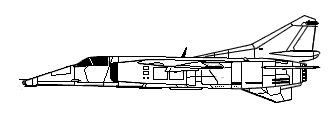 MiG-27
MiG-27
MiG-23BM
(OKB type 32-25 also "Flogger-H") was spotted earlier than the B and BN....
so it was thought that this was the "first" attack version and called MiG-27
"Flogger-D". It apparently was first flown 1972 and used the R-29-300
with a simple afterburner nozzle and got a fixed small splitter plate
and fixed intake. It introduced the canopy without "central frame"
and different thick windscreen.The vertical tail is very similar to the
MiG-23 fighter with still its dorsal fin, but the small auxiliary intake
starboard of the vertical tail was removed. The undercarriage was strengthened
and the nose wheels also enlarged with bulged nose wheel doors. The fuselage
sides at the main gear also shows some bulges, suggesting larger main wheels.
Later aircraft also got the taileron trimtabs.
It was armed
with the GSh-6-30M "Gatling like" gun. Pylons were redesigned to carry
larger and a variety of bombs and also two pylons could be fitted aft of
the main gear bays. Below the starboard wing glove (above the wing pylon)
a fairing is often fitted for the data link for the AS-7 "Kerry" and AS-9
missiles and a TV camera on a similar fairing below the port wing glove.
Later on these were sometimes removed and the mud guard on the nose undercarriage
was also sometimes removed. Also, sometimes provision for the AA-8 "Aphid"
missile. This version was probably used only by the Soviet Union (and some
also in Afghanistan war from 1987).
MiG-23BK (OKB 32-26 "Flogger-H" also) was similar to the MiG-23BM (with thus the simpler fixed intakes) and the ground attack version for the Warsaw Pact countries with some systems and additional radar warning receivers on the air intakes.
MiG-27K
got a laser designator and could fire TV guided air to ground weapons and
also had the GSh-6-30 gun.
MiG-27M
"Flogger-J" ground attack version got newer systems including ECM. It was
based on the MiG-27 "Flogger-D". It had a chin blister with laser in a
much larger fairing and the ILS antenna moved to the upper nose. The missile
pod below the wing glove as well as starboard TV pod were deleted. It got
a LEX extension at the wing glove and often chaff/flare dispensers were
fitted on top of the fuselage at the sides of the dorsal fin. The rudder
got two hinges and the vertical tail leading edge was now used as die-electric
panel. Also it got the GSh-6-23M "gatling like" canon and later the 30
mm GSh-6-30 six-barrel cannon (with two blast shields and it's rear section
was covered). Used probably also used by Sri Lanka.
MiG-27D was the upgraded version of mostly MiG-23BM aircraft to the same MiG-27M standard and thus looking very similar. Probably also used by Kazachstan.
MiG-27L / ML was the export variant of the MiG-27M "Bahadur" for India starting from 1986. It had a "single window" for the infra-red search and track (IRST) sensor. India used large numbers of this version that was license built by Hindustan Aeronautics (HAL).
MiG-27H was an Indian version of HAL with other (French?) avionics established in the early nineties (after the collapse of the East Europe block).
These ground attack MiG-23/ MiG-27 versions were used by the Soviet Union (later Russia, Kazachstan, Ukraine) , Warsaw Pact countries and also in large numbers in India and also by Sri Lanka. Many Third World countries still use them today.
See further
references
listed below.....
..
Page 2
Page 3
Page 4
Page 5
Page 6

MiG OKB
OK, now the kits..
In 1/72 scale there are numerous models. Even in 1/32 scale there is a Trumpeter model which I allready completed a few years ago in a Czech scheme (look at my modelling report here...).
These are some of the 1/72 MiG-23 kits ....
The very old Airfix probably
from 1980 and USAirfix releases:
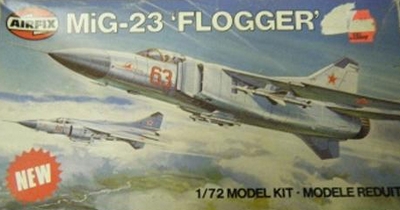 .
.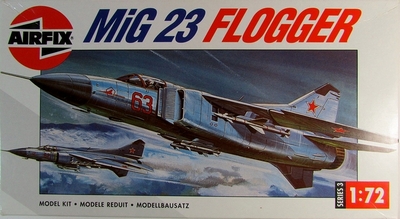 .
.
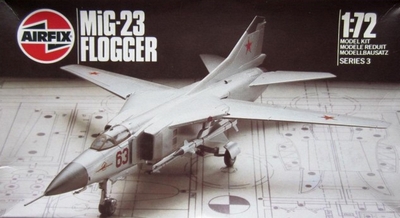 .
.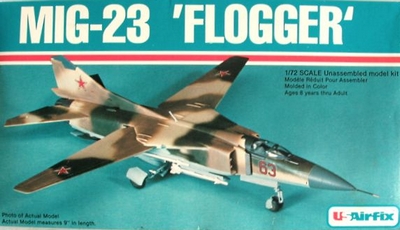
and probably the same kit in the
Heller rebox with new decals:
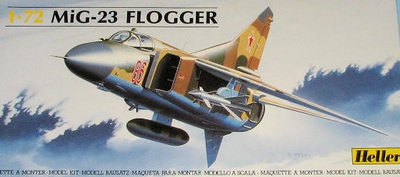
------------
The old Hasegawa
kit:
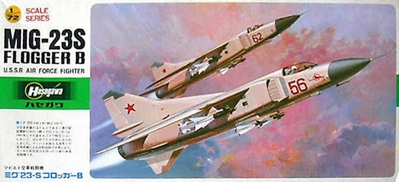 .
.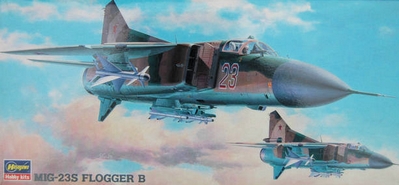 .
.
and the same old kit at double "special
livery" prices in 2008...
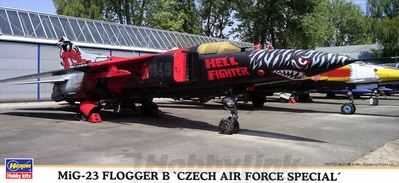
and its same Hasegawa kit in the
Minicraft series:
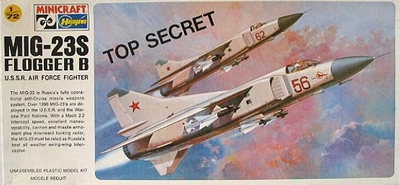 .
.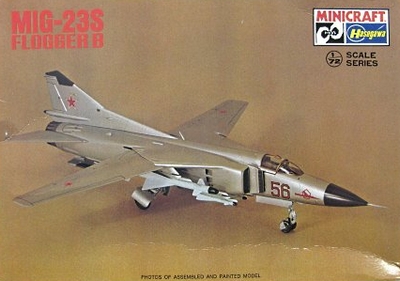
----------------------
The old
Academy kit which looks very familiar to the Hasegawa kit and
probably is a "copy" of the old Hasegawa kit:
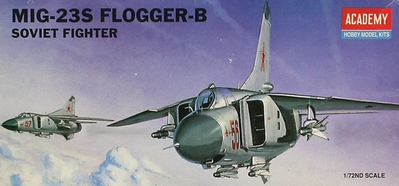 .
.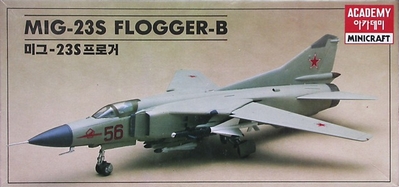 .
.
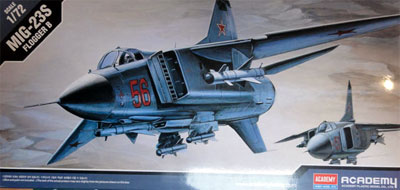 .
.
The Academy
kit for a MiG-27 "Flogger" attack version:
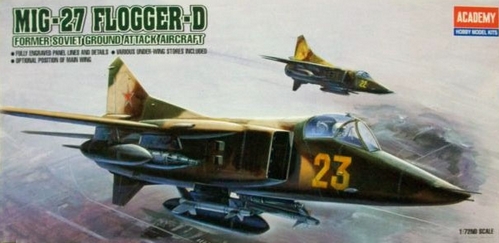 .
. .
.
----------
The Zvezda
kit of Russia of the MiG-23 (but parts look to be for a MLD and not a MF):
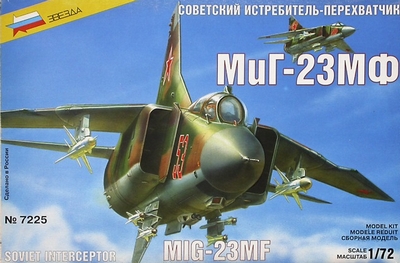
and for the MLD (now quoted correctly
and probably the same kit):
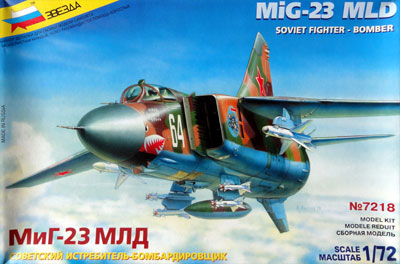 .
.
(The same mould is also probably
used in the BILEK kit )

and the Italeri kit using the Zvezda
moulds:
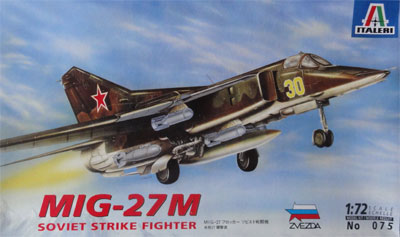 ..
..
=============
and the more recent and far better
kits, starting with ArtModel for a two seater UB:
 .
.
==============
and accurate RV Aircraft kit in different
versions:
 .
.
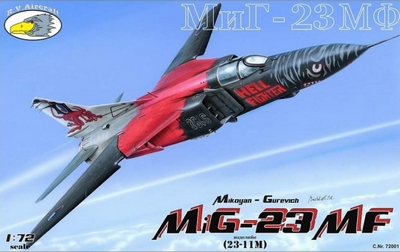 .
.

I did not have all these kits on the stack, but quite a few... so let's start modelling the MiG-23 kits......
On to next
[ Page 2 ... ]
REFERENCES
- OKB MiG, Butowski and Miller, Aerofax inc, 1991
- World Air Power series, special article, Vol. 08 , page 40-95 etc., 1992
- Air international magazine, vol 66, pages 44 etc
- Mikoyan Gurevich MiG-23 in action, Squadron Signal, 1990
- Mikoyan Gurevich MiG-23MF , 4+ publications
- Mikoyan Gurevich MiG-23BN, Hera publications, Czech, 1993
- Mikoyan Gurevich MiG-23 , bibilothek lotnictwo, Poland, 1999
- Soviet and Russian Military aircraft series: (1) in Asia, (2) in Africa, (3) in Middle East; by Yefim Gordon and Kommissarov, Hikoki publications
- African MiGs, Volumes 1 and 2, Tom Cooper, Harpia publishing, 2010
Back to 1/72 Models.......
(c) Copyright Meindert "designer"/ All rights reserved. Your comments are welcomed by webmaster
Created this page
February 8, 2016